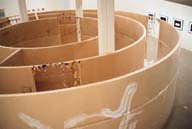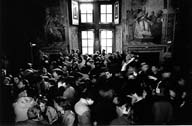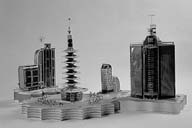L'edicola digitale delle riviste italiane di arte e cultura contemporanea
Flash Art Int. (1999 - 2001) Anno 33 Numero 211 March-April 2000
Mirror's Edge
Helena Kontova

Franz Ackermann
Wolf-Günter Thiel and Milena Nikolova
n. 216 Jan-Feb 2001
Shangai Biennale
Satoru Nagoya
n. 216 January-February 2001
Aperto Albania
Edi Muka
n. 216 January-February 2001
Cecily Brown and Odili Donald Odita
n. 215 November-December 2000
Cai Guo-Qiang
Evelyne Jouanno
n. 215 November-December 2000
Aperto New York
Grady T. Turner
n. 213 summer 2000



An interview with curator Okwui Enwezor Helena Kontova Helena Kontova: Can we consider "Mirror's Edge" as a kind of rehearsal theater or laboratory for Documenta11? Okwui Enwezor: It goes without saying that an exhibition such as "Mirror's Edge,"which looks intensely and critically at the work of established, young, and emerging artists in the context of contemporary art would trigger speculation as to whether it provides a model or point of for Documenta 11. For me, while it's a fair question, in reality there is no direct connection between this exhibition and Documenta 11, although of course, I remain interested in and curious about all areas ofproduction and newpropositions from the artists in the show, whether for Documenta or any other exhibition I may be planning.
Helena Kontova: The exhibition is divided into rooms. Each of them very different in concept and sensibility. Can you explain to us the differences and the ideas behind the various rooms?
Okwui Enwezor: The Bildmuseet architecture is very difficult to work with. It is a hybrid architecture with no distinction, no spatial identity, at least with what many of us may be accustomed to in museum buildings. The challenge of making the exhibition work both spatially and conceptually, as well as with a clear temporal rigour,involved designing and orienting the exhibition rooms (9 in all, from large, quite handsome open spaces to small, contained, discreet rooms) along a route that pays great attention to the character of each work and each work's relationship to the overall layout of the exhibition and response to the other works. The exhibition spaces are on two levels, with varying heights,nothing was consistent, in terms of geometry, from one room to another. This presented a clear challenge because I was interested in providing a careful,deliberate, and calibrated experience of each space and installation, to raise, so to speak, the critical acuity of the viewer or listener. My intention was to work with two ideas, one was slowness and speed, experience and reflection, interaction and engagement. I wanted to construct a route throughout the exhibition in which the idea of unfolding and things doubling into each other creates a density in the body of the show while ensuring that each work retains its integrity and self sufficiency. I am always careful not to be so over zealous with works of art that they become mere illustrations for the grand curatorial idea. So it was necessary to create clear spaces for each work even though they may be placed in extreme tension and close proximity to one another. For example, one moves from the idea of urban space as in the case of Peter Spaansís video walk to Henrik Hakaansonís quasi-investigation of nature through the translocation of a piece of the natural habitat into the museum,which is then magnified through a live and continuous broadcast of sounds from that habitat which confronts the aggressive, yet playful digital soundscape by Cultural Alchemy. I call these mixtures and distensions,"soft borders," ideas which allow spatial continuity, but constant temporal dislocations and interruptions. Ultimately,however, each work had such precision that one had to be careful not to over dramatize the installation and turn it into pure reverie.
HK: Few of the artists (Ceal Floyer, Thomas Demand) had their works in more than one place, while Thomas Hirschhorn and Francis Alÿs's installations were each situated in their own room. What was the reason for dislocating some of the artistsí works?
OE: Well, the idea lies in what I mentioned before,which was to maintain soft borders between different attitudes, propositions, and investigations. Hirschhorn's "sculpture/installations" tend to appear overwhelming and excessive upon first contact, with a surplus of material,energy, and information coming at the viewer from all angles. But it seems to me that the sculptural attitude of Hirschhorn's work, despite the grandness of its initial manifestation, is really anti-monumental. And Thomas has developed this critical way of looking at the condition of sculptural production within late capitalism, working with both the idea of history and consciousness, and the notion of obsolescence as part of the excess of consumption as a means of recharging dead objects with meaning. Thus if the work is to be properly understood, a clear articulate space always has to be established to allow it to be discovered and read according to its own logic, complexity, and density. The work he made for "Mirror"s Edge" is based on the dialectic of certain forms of consciousness and experience, working with intensities that are both visual and experiential. It needed to have its own space which Thomas did not want to be artificial, he wanted to make and transform an already existing space within the museum, without isolating the work from the rest of the exhibition. So we found the museum storage room which abuts the exhibition spaces and it worked beautifully. As for Francis Alÿs, it was just a simple issue of providing the right conditions for his cinematic and musical essay which he calls Music Video. It was the most difficult room to install because it was not a proper viewing room and the sound quality needed to be better than it was. But overall, it worked as best as it could. As for Demand and Floyer, Demand's photographs seem the most eclectic, yet conceptually quite focused. In fact, installing his Studio in such wonderful proximity to Liisa Roberts's to derive an approach made it quite clear that they are both working with a sculptural scheme that often is misread as illusionistic in terms of their visual manifestation. So it worked fantastically to have both pieces face each other so that the ideas of space, the disruption of a given narrative stability in each work is made apparent in the seams that each artist creates in their work. I wanted the viewer to walk from Liisa's piece into Demand's room without any interruption and yet to have a feeling of encountering each work on its own ground, this is the same for the rest of Demand's other pieces in relation to Sophie Tottie, N55, Olu Oguibe and Cultural Alchemy or downstairs to Bodys Isek Kingelez. As for Floyer, the works have such strong conceptual tightness that sometimes it's easy to miss it or the point of it. The two pieces in the exhibition complemented each other well in the fact that they reanimated dead spaces in ways that helped the exhibition.
HK: Visiting your exhibition it seems like you were more inspired by sensibility than theoretical concepts. Could you explain to us how you proceed in your work with regards to these two approaches?
OE: I did not want to make an exhibition that flagged its theoretical ambitions. I wanted to proceed from theory into the work, and then to allow the work to overwhelm the theory so that although the theoretical concerns may be there, they does not constantly call attention to themselves. I wanted the exhibition to work in and around the folds and shadows of theory; I wanted to set up an incommensurate relationship between the curatorial idea and the art work. I believe I began by pointing to the fact that I wanted a clear view of the art work. I organized the exhibition with the clear intention of placing the work in front of the public not only in relation to the phenomenological questions they call our attention to but also the social, political, cultural, and economic constructions around which orbit what Frederic Jameson has called our post-contemporary perspectives. As I see it, there is no paradox in trying to find a relationship between sensibility and theory. In fact, the very idea of "Mirror's Edge" is predicated as much on the issues of such constructions between fiction and reality as it is on reading critically ideas around traditional creation myths. It started by first looking at Las Meninas,Velazquez's painting in the Prado in Madrid and returning to Foucault's incredibly eloquent reading of the painting. As you can see the theory does accompany the work of art, it grounds the art work in clear philosophical and epistemological conditions.Therefore in order to call attention to how contemporary artists have made critical use of philosophy and other disciplines, it was important to make an exhibition that did not domesticate the art object and turn it into a prop for theoretical speculation,but to let art and theory engage in an exchange.
Helena Kontova is the Editor of Flash Art. "Mirror's Edge" at BildMuseet,Umea, closed on February 20. Exhibition tour:Vancouver Art Gallery, March 18 - July 9, 2000; Castello di Rivoli, Turin, October 5, 2000 - January 14, 2001;Tramway, Glasgow, March 2, 2001 - April 15, 2001.


